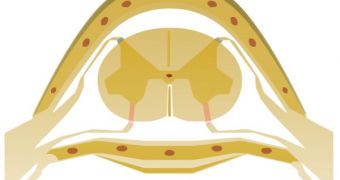Spinal cord injuries are among the most dangerous of the lot, because it's very easy to section or otherwise damage nerves. When this happens, paralysis usually ensues, drastically affecting patients' quality of life. Therefore, finding solutions to remedy the nerve problem faster has been one of the main objectives in medicine for many years. In a groundbreaking, new development, experts at the St. Joseph's Hospital and Medical Center Barrow Neurological Institute announce that injecting biomaterial gel into a spinal-cord injury site provides faster and more effective healing.
The investigation, on which experts from the Purdue University and the Arizona State University (ASU) also collaborated, also revealed that hydrogels could represent a “practical path” to future treatments designed specifically to combat spinal injury damage. The full details of the research appear in the latest issue of the Journal of Neurosurgery. The science team was led by BNI expert Mark Preul, and Purdue University investigator Alyssa Panitch, PhD.
“Spinal cord injury is devastating to civilian and military populations – especially to the young. There has been little progress toward paradigms of regeneration and few results that show real, sustained functional recovery. We've been so preoccupied with regeneration, but that is a highly complicated and difficult to define goal. This project is a synergy of neurosurgeons and bioengineers that attempts repair of the SCI lesion cavity using a tissue-engineering biomaterials approach,” Preul says.
The bioengineered hydrogel is made almost fully out of hyaluronic acid, which is a substance produced naturally by the body. Its main effect on spinal cords is to prevent scarring (one of the most damaging side-effects), and also to promote the correct rearrangement of spinal nerve fibers in their natural positions. The way it manages to do that is by creating a scaffold-like structure at the injury site, essentially helping stabilize the entire area. The healing process can work faster because of this.
“In this project we did not add anything to the hyaluronic acid. It may be that adding growth factors or cells into the gel matrix may allow even better results. We may be on a practical path that can give hope to the many people who suffer this sort of injury,” Preul adds. The investigation was supported by a $450,000 grant from the Arizona Biomedical Research Commission. When presented at the annual meeting of the American Association of Neurological Surgeons, held in San Diego, it won the Synthes Prize for Spine Research.

 14 DAY TRIAL //
14 DAY TRIAL //